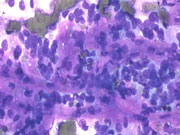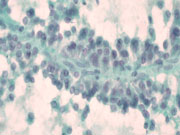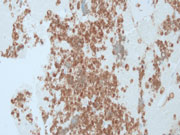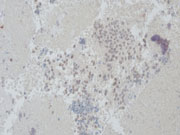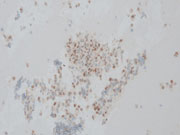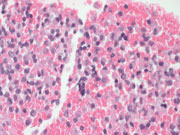Case of the Month ...
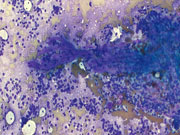
A 58-year-old female presented with a few days of constant right-sided abdominal pain. MRI and endoscopic ultrasound (EUS) showed a 2.4 x 2.2 cm round, hypoechoic and calcified mass with poorly defined borders in the pancreatic tail without pancreatic duct dilation. An EUS-guided fine needle aspiration (FNA) biopsy of the pancreatic tail mass was performed.
Authors
- Mennatallah Ewais, MD; Qiuying (Judy) Shi, MD. Department of Pathology and Laboratory Medicine, Emory University Hospital, Atlanta, GA.
Diagnosis & Discussion
click on image for larger version
Figure 3 Figure 4 Figure 5 Figure 6 Figure 7 Figure 8 Images 1-6:
- Figure 1: Diff-Quik Stain,100x
- Figure 2: Diff-Quik Stain, 400x
- Figure 3: Papanicolaou Stain, 100x
- Figure 4: Papanicolaou Stain, 400x
- Figure 5: Beta-catenin, 200x
- Figure 6: LEF1, 200x
- Figure 7: SOX11, 200x
- Figure 8: H&E, 400x
Questions:
- Based on the clinical history, morphology, and immunohistochemistry, which of the following is the most appropriate diagnosis?
- Well differentiated neuroendocrine tumor
- Solid Pseudopapillary Neoplasm
- Acinar Cell Carcinoma
- Pancreatoblastoma
- Which of the following is the most common gene mutation detected in this lesion?
- KRAS
- TP53
- KIT
- CTNNB1
Answers:
Question 1: Correct answer is B
The FNA specimen was highly cellular and showed cohesive and discohesive cells. On the Diff-Quik stain, delicate papillary fronds with dense myxoid stroma (magenta), uniform round-to-oval bland-appearing nuclei, and scant-to-moderate cytoplasm were present. Cytoplasmic eosinophilic hyaline globules were seen occasionally. On the Papanicolaou stain, the nuclei demonstrated finely dispersed chromatin and eccentrically-located pinpoint nucleoli.
Immunohistochemical stains were performed. The tumor cells showed aberrant nuclear and cytoplasmic β- catenin expression. Mutations of the β-catenin gene (CTNNB1) are present in the majority of the cases. Through this mutation, the Wnt signaling pathway activates several oncogenic genes, leading to overexpression of other Wnt pathway transcription regulators such as SOX11 and LEF11-4.
Solid pseudopapillary neoplasm (SPN) may demonstrate plasmacytoid cells and express synaptophysin and CD56, which may be misinterpreted as a well differentiated neuroendocrine tumor (WDNET). However, SPNs have pale chromatin and are negative for chromogranin A and PanCK, whereas WDNETs have salt-and-pepper chromatin and are positive for chromogranin and PanCK. Trypsin and chymotrypsin markers can help to differentiate acinar cell carcinoma, which can also have papillary/papillocystic pattern. Although pancreatoblastoma can express β- catenin, it typically shows multilineage differentiation with squamoid morules. The patient underwent surgical resection that confirmed SPN.Question 2: Correct answer is D
Almost all SPNs have alterations in the APC/β-catenin pathway5. β-catenin protein plays a role in the Wnt signaling pathway as a downstream transcriptional activator5. These mutations result in cytoplasmic/nuclear expression of β-catenin. E- cadherin expression can also be aberrant because of CTNNB1 alterations6. In addition, CTNNB1 alterations can affect the transcription of several genes, including the cyclin D1 oncogene, which results in the nuclear overexpression of cyclin D17. SPN lacks genetic alterations, such as KRAS, TP53, and SMAD47, commonly present in ductal adenocarcinoma.References:
- Harrison G, Hemmerich A, Guy C, et al. Overexpression of SOX11 and TFE3 in solid- pseudopapillary neoplasms of the pancreas. Am J Clin Pathol. 2017;149:67- 75.
- Singhi AD, Lilo M, Hruban RH, Cressman KL, et al. Overexpression of lymphoid enhancer- binding factor 1 (LEF1) in solid- pseudopapillary neoplasms of the pancreas. Mod Pathol. 2014;27:1355- 1363.
- Wang Q, Reid MD. Cytopathology of solid pancreatic neoplasms: An algorithmic approach to diagnosis. Cancer Cytopathol. 2022;130(7):491-510.
- Behrens J, von Kries JP, Kuhl M, et al. Functional interaction of β-catenin with the transcriptional factor LEF-1. Nature. 1996;382:638- 642.
- Abraham SC, Klimstra DS, Wilentz RE, et al. Solid- pseudopapillary tumors of the pancreas are genetically distinct from pancreatic ductal adenocarcinomas and almost always harbor beta- catenin mutations. Am J Pathol. 2002;160:1361- 1369.
- Chetty R, Serra S. Membrane loss and aberrant nuclear localization of E-cadherin are consistent features of solid pseudopapillary tumor of the pancreas. An immunohistochemical study using two antibodies recognizing different domains of the E- cadherin molecule. Histopathology. 2008;52:325- 330.
- La Rosa S, Bongiovanni M. Pancreatic Solid Pseudopapillary Neoplasm: Key Pathologic and Genetic Features. Arch Pathol Lab Med. 2020;144(7):829-837.
